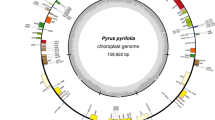Abstract
Recent evidence suggests chloroplast introgression fromMicroseris bigelovii intoM. douglasii. We have examined 23 plants from a population ofM. douglasii polymorphic forM. douglasii andM. bigelovii chloroplast types. All 23 plants were completely homozygous for morphological and RAPD markers, and inbred lines derived by selfing have been used for DNA analysis. Chloroplast RFLP analysis identified 16 plants withM. bigelovii chloroplasts and seven withM. douglasii chloroplasts. The nuclear genomes of the 16 plants withM. bigelovii chloroplasts were examined with 22 primers for RAPD amplification products shared exclusively withM. bigelovii. Five of 268 markers appeared to be shared betweenM. bigelovii and one or more of these 16 plants on the basis of their position in gels. Detailed examination of these five amplification products showed that none of them are nuclear DNA fromM. bigelovii. Very little, if any, nuclear DNA fromM. bigelovii can be present inM. douglasii plants with chloroplasts typical ofM. bigelovii. The study demonstrates the usefulness of the RAPD technique for screening large numbers of markers to select a few potentially informative ones for rigorous examination.
Similar content being viewed by others
References
Bachmann, K., 1992: Nuclear DNA markers in angiosperm taxonomy. — Acta Bot. Neerl.41: 369–384.
—, 1994: Molecular markers in plant ecology. — New Phytologist126: 403–418.
—, 1994: Variability in a predominantly self-fertilizing annual with fragmented distribution,Microseris douglasii (Asteraceae, Lactuceae). — Biol. Zentralblatt113: 69–95.
—, 1996: Mapping genes for phenotypic variation inMicroseris (Lactuceae) with molecular markers. — InCaligari, P. D. S., Hind, D. J. N., (Eds):Compositae: biology & utilization,2, pp. 23–43. — Richmond: Royal Botanical Gardens, Kew.
—, 1995: Phenotypic plasticity and parent/offspring regression of characters in inbred strains ofMicroseris douglasii (Asteraceae, Lactuceae). — Biol. Zentralblatt114: 67–82.
Battjes, J., Chambers, K. L., Bachmann, K., 1994: Evolution of microsporangium numbers inMicroseris (Asteraceae, Lactuceae). — Amer. J. Bot.81: 641–647.
Chambers, K. L., 1955: A biosystematic study of the annual species ofMicroseris. — Contrib. Dudley Herbarium4: 207–312.
Clark, A. G., Lanigan, C. M. S., 1993: Prospects for estimating nucleotide divergence with RAPDs. — Molec. Biol. Evol.10: 1096–1111.
Corriveau, J. L., Coleman, A. W., 1988: Rapid screening method to detect potential biparental inheritance of plastid DNA and results over 200 angiosperm families. — Amer. J. Bot.75: 1443–1458.
Hadrys, H., Balick, M., Schierwater, B., 1992: Applications of random amplified polymorphic DNA (RAPD) in molecular ecology. — Molec. Ecol.1: 55–63.
Hombergen, E. J., Bachmann, K., 1995: RAPD mapping of 3 QTLs determining trichome formation inMicroseris Hybrid H27 (Asteraceae, Lactuceae). — Theor. Appl. Genet.90: 853–858.
Jansen, R. K., Palmer, J. D., 1987: Chloroplast DNA from Lettuce andBarnadesia (Asteraceae): structure, gene localization, and characterization of a large inversion. — Curr. Genet.11: 553–564.
Mason, R. J., Holsinger, K. E., Jansen, R. K., 1994: Biparental inheritance of the chloroplast genome inCoreopsis (Asteraceae). — J. Heredity85: 171–173.
Rieseberg, L. H., 1996: Homology among RAPD fragments in interspecific comparisons. — Molec. Ecol.5: 99–105.
—Whitton, J., Linder, C. R., 1996a: Molecular marker incongruence in plant hybrid zones and phylogenetic trees. — Acta Bot. Neerl. (in press).
—, 1996b: Role of gene interactions in hybrid speciation: evidence from ancient and experimental hybrids. — Science277: 741–745.
Roelofs, D., Bachmann, K., 1995: Chloroplast and nuclear DNA variation among homozygous plants in a population of the autogamous annualMicroseris douglasii (Asteraceae, Lactuceae). — Pl. Syst. Evol.196: 185–194.
—, 1997: Comparison of chloroplast and nuclear phylogeny in the autogamous annualMicroseris douglasii (Asteraceae, Lactuceae). — Pl. Syst. Evol.204: 49–63.
Saghai-Maroof, M. A., Soliman, K. M., Jorgensen, R. A., Allard, R. W., 1984: Ribosomal DNA spacer-length polymorphisms in barley: Mendelian inheritance, chromosomal location, and population dynamics. — Proc. Natl. Acad. Sci. USA81: 8014–8018.
Soltis, D. E., Kuzoff, R. K., 1995: Discordance between nuclear and chloroplast phylogenies in theHeuchera group (Saxifragaceae). — Evolution49: 727–742.
—, 1989: Alloploid speciation inTragopogon: insights from chloroplast DNA. — Amer. J. Bot.76: 1119–1124.
Swofford, D. L., 1993: PAUP: phylogenetic analysis using parsimony, version 3.1. Formerly distributed by Illinois Natural History Survey, Champaign, Illinois.
Van Houten, W. J. H., Scarlett, N., Bachmann, K., 1993: Nuclear DNA markers of the Australian tetraploidMicroseris scapigera and its North American diploid relatives. — Theor. Appl. Genet.87: 498–505.
Wallace, R. S., Jansen, R. K., 1990: Systematic implications of chloroplast DNA variation in the genusMicroseris (Asteraceae: Lactuceae). — Syst. Bot.15: 606–616.
Welsh, J., McClelland, M., 1990: Fingerprinting genomes using PCR with arbitrary primers. — Nucleic Acids Res.18: 7213–7218.
Whitkus, R., Doebley, J., Wendel, J. F., 1994: Nuclear DNA markers in systematics and evolution. —Phillips, R. L., Vasil, I. K., (Eds): DNA-based markers in plants, pp. 116–141. — Dordrecht: Kluwer.
Williams, J. G., Kubelik, A. R., Livak, K. J., Rafalski, J. A., Tingey, S. V., 1990: DNA polymorphisms amplified by arbitrary primers are useful as genetic markers. — Nucleic Acids Res.18: 6531–6535.
Author information
Authors and Affiliations
Additional information
Dedicated to emer. Univ.-Prof. DrFriedrich Ehrendorfer on the occasion of his 70th birthday
Rights and permissions
About this article
Cite this article
Roelofs, D., Bachmann, K. Genetic analysis of aMicroseris douglasii (Asteraceae) population polymorphic for an alien chloroplast type. Pl Syst Evol 206, 273–284 (1997). https://doi.org/10.1007/BF00987952
Received:
Revised:
Accepted:
Issue Date:
DOI: https://doi.org/10.1007/BF00987952




